Storage controller setup
 Suggest changes
Suggest changes


This section describes the configuration of the NetApp storage system. You must complete the primary installation and setup according to the corresponding ONTAP setup and configuration guides.
Storage efficiency
Inline deduplication, cross- volume inline deduplication, inline compression, and inline compaction are supported with SAP HANA in an SSD configuration.
Enabling the storage efficiency features in an HDD configuration is not supported.
NetApp FlexGroup Volumes
The usage of NetApp FlexGroup Volumes is not supported for SAP HANA. Due to the architecture of SAP HANA the usage of FlexGroup Volumes does not provide any benefit and may results in performance issues.
NetApp Volume and Aggregate Encryption
The use of NetApp Volume Encryption (NVE) and NetApp Aggregate Encryption (NAE) are supported with SAP HANA.
Quality of Service
QoS can be used to limit the storage throughput for specific SAP HANA systems or non-SAP applications on a shared controller.
Production and Dev/Test
One use case would be to limit the throughput of development and test systems so that they cannot influence production systems in a mixed setup.
During the sizing process, you should determine the performance requirements of a nonproduction system. Development and test systems can be sized with lower performance values, typically in the range of 20% to 50% of a production-system KPI as defined by SAP.
Large write I/O has the biggest performance effect on the storage system. Therefore, the QoS throughput limit should be set to a percentage of the corresponding write SAP HANA storage performance KPI values in the data and log volumes.
Shared Environments
Another use case is to limit the throughput of heavy write workloads, especially to avoid that these workloads have an impact on other latency sensitive write workloads.
In such environments it is best practice to apply a non-shared throughput ceiling QoS group-policy to each LUN within each Storage Virtual Machine (SVM) to restrict the max throughput of each individual storage object to the given value. This reduces the possibility that a single workload can negatively influence other workloads.
To do so, a group-policy needs to be created using the CLI of the ONTAP cluster for each SVM:
qos policy-group create -policy-group <policy-name> -vserver <vserver name> -max-throughput 1000MB/s -is-shared false
and applied to each LUN within the SVM. Below is an example to apply the policy group to all existing LUNs within an SVM:
lun modify -vserver <vserver name> -path * -qos-policy-group <policy-name>
This needs to be done for every SVM. The name of the QoS police group for each SVM needs to be different.
For new LUNs, the policy can be applied directly:
lun create -vserver <vserver_name> -path /vol/<volume_name>/<lun_name> -size <size> -ostype <e.g. linux> -qos-policy-group <policy-name>
It is recommended to use 1000MB/s as maximum throughput for a given LUN. If an application requires more throughput, multiple LUNs with LUN striping shall be used to provide the needed bandwidth. This guide provides an example for SAP HANA based on Linux LVM in section Host Setup.

|
The limit applies also to reads. Therefore use enough LUNs to fulfil the required SLAs for SAP HANA database startup time and for backups. |
NetApp FabricPool
NetApp FabricPool technology must not be used for active primary file systems in SAP HANA systems. This includes the file systems for the data and log area as well as the /hana/shared file system. Doing so results in unpredictable performance, especially during the startup of an SAP HANA system.
Using the “snapshot-only” tiering policy is possible as well as using FabricPool in general at a backup target such as SnapVault or SnapMirror destination.

|
Using FabricPool for tiering Snapshot copies at primary storage or using FabricPool at a backup target changes the required time for the restore and recovery of a database or other tasks such as creating system clones or repair systems. Take this into consideration for planning your overall lifecycle- management strategy, and check to make sure that your SLAs are still being met while using this function. |
FabricPool is a good option for moving log backups to another storage tier. Moving backups affects the time needed to recover an SAP HANA database. Therefore, the option “tiering-minimum-cooling-days” should be set to a value that places log backups, which are routinely needed for recovery, on the local fast storage tier.
Configure storage
The following overview summarizes the required storage configuration steps. Each step is covered in more detail in the subsequent sections. Before initiating these steps, complete the storage hardware setup, the ONTAP software installation, and the connection of the storage FCP ports to the SAN fabric.
-
Check the correct disk shelf configuration, as described in Disk shelf connections.
-
Create and configure the required aggregates, as described in Aggregate configuration.
-
Create a storage virtual machine (SVM), as described in Storage virtual machine configuration.
-
Create logical interfaces (LIFs), as described in Logical interface configuration.
-
Create initiator groups (igroups) with worldwide names (WWNs) of HANA servers as described in the section link:hana-fas-fc-storage-controller-setup.html#initiator-groups Initiator groups.
-
Create and configure volumes and LUNs within the aggregates as described in the section Single Host Setup for single hosts
or in section Multiple Host Setup for multiple hosts
Disk shelf connections
With HDDs, a maximum of two DS2246 disk shelves or four DS224C disk shelves can be connected to one SAS stack to provide the required performance for the SAP HANA hosts, as shown in the following figure. The disks within each shelf must be distributed equally to both controllers of the HA pair.
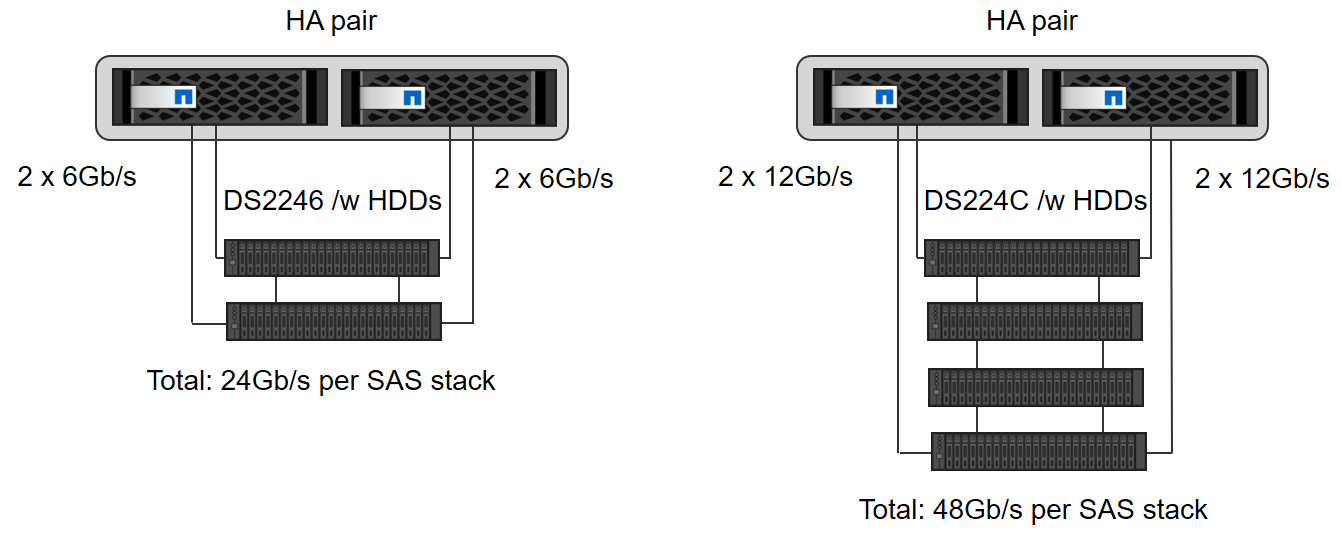
With SSDs, a maximum of one disk shelf can be connected to one SAS stack to provide the required performance for the SAP HANA hosts, as shown in the following figure. The disks within each shelf must be distributed equally to both controllers of the HA pair. With the DS224C disk shelf, quad-path SAS cabling can also be used but is not required.

NVMe disk shelves
Each NS224 NVMe disk shelf is connected with two 100GbE ports per controller, as shown in the following figure. The disks within each shelf must be distributed equally to both controllers of the HA pair.
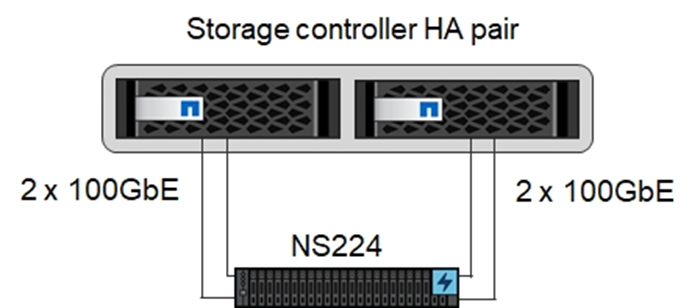
Aggregate configuration
In general, you must configure two aggregates per controller, independent of which disk shelf or disk technology (SSD or HDD) is used. This step is necessary so that you can use all available controller resources. For FAS 2000 series systems, one data aggregate is sufficient.
Aggregate configuration with HDDs
The following figure shows a configuration for eight SAP HANA hosts. Four SAP HANA hosts are attached to each storage controller. Two separate aggregates, one at each storage controller, are configured. Each aggregate is configured with 4 × 10 = 40 data disks (HDDs).
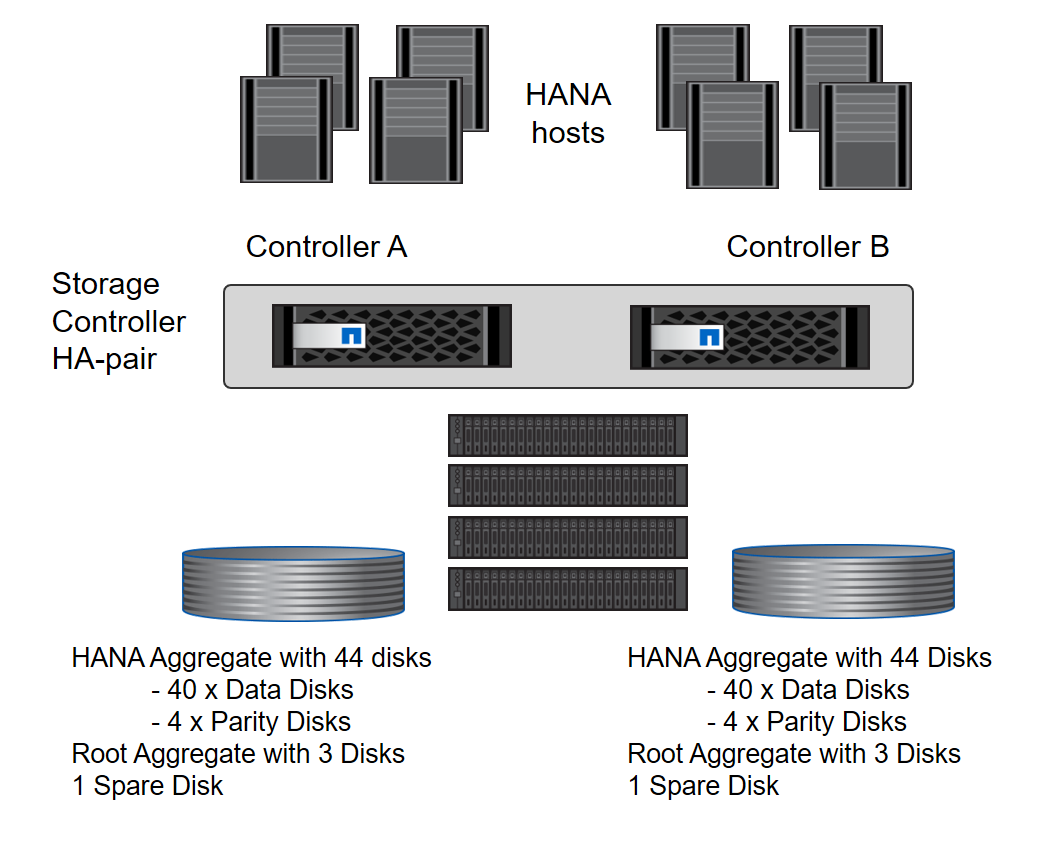
Aggregate configuration with SDD-only systems
In general, two aggregates per controller must be configured, independently of which disk shelf or disk technology (SSDs or HDDs) is used.
The following figure shows a configuration of 12 SAP HANA hosts running on a 12Gb SAS shelf configured with ADPv2. Six SAP HANA hosts are attached to each storage controller. Four separate aggregates, two at each storage controller, are configured. Each aggregate is configured with 11 disks with nine data and two parity disk partitions. For each controller, two spare partitions are available.
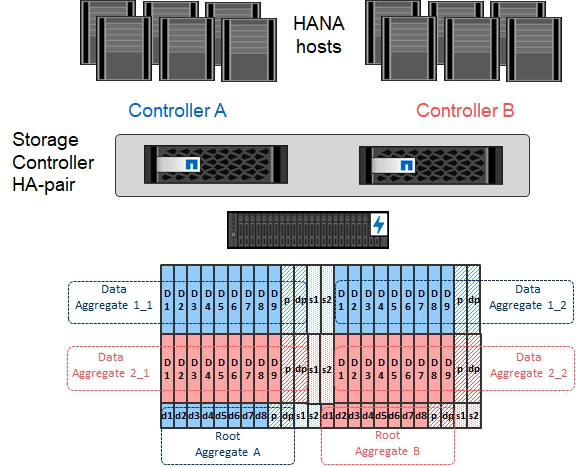
Storage virtual machine configuration
Multiple-host SAP landscapes with SAP HANA databases can use a single SVM. An SVM can also be assigned to each SAP landscape if necessary in case they are managed by different teams within a company. The screenshots and command outputs in this document use an SVM named hana.
Logical interface configuration
Within the storage cluster configuration, one network interface (LIF) must be created and assigned to a dedicated FCP port. If, for example, four FCP ports are required for performance reasons, four LIFs must be created. The following figure shows a screenshot of the eight LIFs that were configured on the SVM.
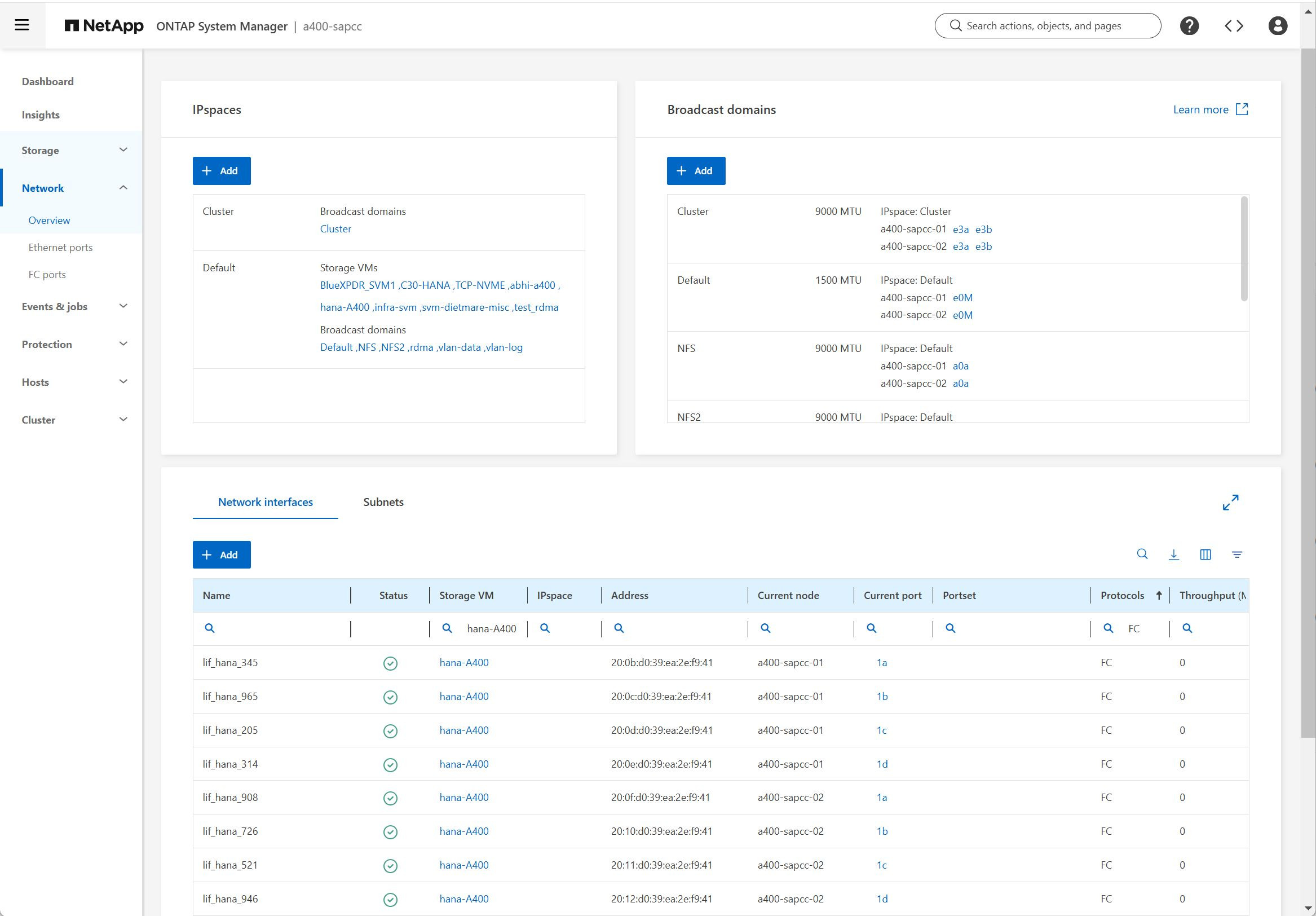
During SVM creation with ONTAP 9 System Manager, all the required physical FCP ports can be selected, and one LIF per physical port is created automatically.
The following figure depicts the creation of SVM and LIFs with ONTAP System Manager.
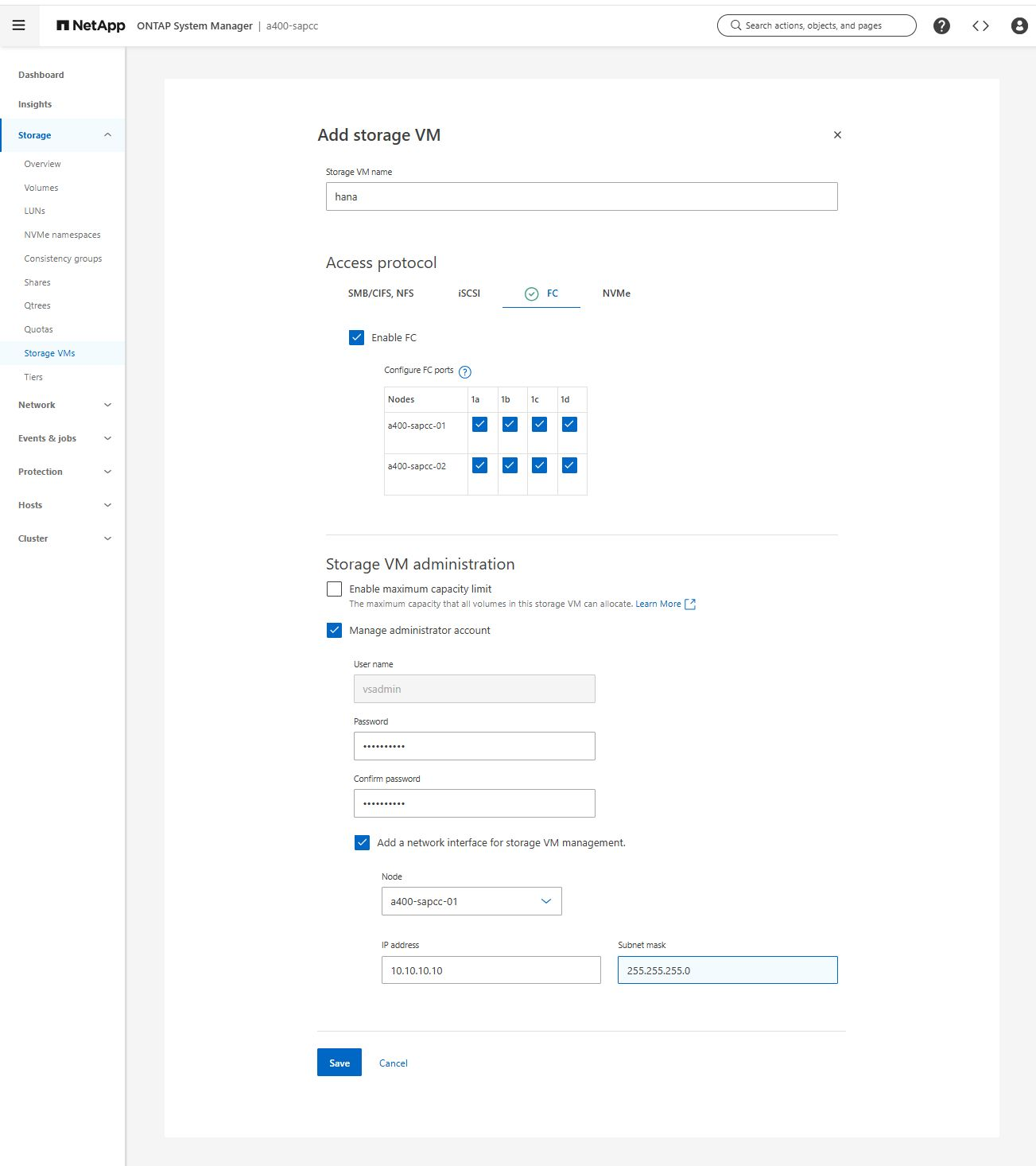
Initiator groups
An igroup can be configured for each server or for a group of servers that require access to a LUN. The igroup configuration requires the worldwide port names (WWPNs) of the servers.
Using the sanlun tool, run the following command to obtain the WWPNs of each SAP HANA host:
stlrx300s8-6:~ # sanlun fcp show adapter /sbin/udevadm /sbin/udevadm host0 ...... WWPN:2100000e1e163700 host1 ...... WWPN:2100000e1e163701

|
The sanlun tool is part of the NetApp Host Utilities and must be installed on each SAP HANA host. More details can be found in section Host setup.
|
The initiator groups can be created using the CLI of the ONTAP Cluster.
lun igroup create -igroup <igroup name> -protocol fcp -ostype linux -initiator <list of initiators> -vserver <SVM name>


